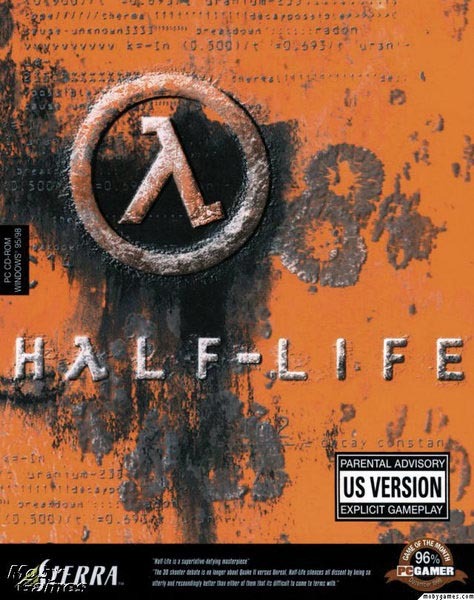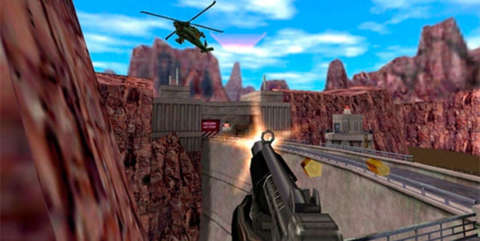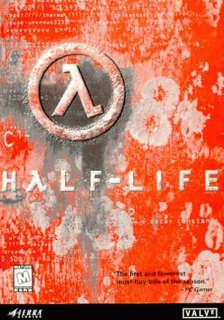I remember, back when print was relevant subscribing to PC GAMER UK. Flicking through the pages, my young eyes came across bold lettering proclaiming "The Woodstock of gaming" accompanied by a vividly bright orange and blue image of a canyon.
Embellishment was nothing new, and certainly hasn't disappeared, if anything the hype machine is more bloated than ever. But here was a rare case where bombastic declarations, met the product.
To modern gamers, this will be much less impressive. After all, every first person shooter since has emulated it in some form, but at the time, this was a revelation, many of it's elements had been done before, but none so impressively cohesive.
It's extended tram intro has been done to death and to this day is copied in genres outside of FPS. This, to most gamers, was a new concept. An introductory prologue immersing the player in the world before the fire-works start. It's effect was profound, instead of feeling like a set of pre-made levels with a vague premise, it was a lived in place, taking an extended lengh of time to set up it's world, this in turn, made the game have more tangibility when it descended into familiar shooting.
Even then, scripted sequences were used, another staple that continues to this day. Arguably... it was better in Halflife, as, instead of tight-fistedly` removing control from the player to the determent of the gameplay, it accompanies and compliments it adding a trickle, rather than a barrage of events, subtly reached a crescendo, rather than beginning with one.
It's story is essentially a disaster movie akin to War Of Worlds. While in War of The Worlds aliens come from the ground, here, they come from a man made portal. Like war of worlds, as the story progresses, it becomes apparent it is less a war, and rather a eradication. The player, in true hero fashion, becomes the savoir, but unlike many games, starts are a mere generic character in a world of generic characters, attempting at first, to simply survive. It's somewhat grounded, regardless of it's ridiculousness, lending credibility where many games at the time faltered.
Of interest in Halflife is it's marines, devilishly aggressive AI that operated in an unbelievable organic manner. Radio chatter, pulling back, flanking, secondary fire. These fellows were so impressive that Halflife 2's combine soldiers seems oddly inept in comparison. It was first class example of how terrific AI could, and can be.
The aliens are a much more simple affair, but designed so that weapons work in tandem. Typically, a crowbar for a head crab (a creature ripped straight out aliens) or double shotgun for Vortigon and so on... Each is distinct, some (as highlighted in Raising The Bar) are deliberately sexual in true Giger fashion to illicit a negative response from homophobic teenagers, very clever stuff.
Occasional set pieces help the player feel less like the center of the universe, and more a cog in the wheel of a greater story. Scientists killed off by marines, marines fighting aliens in a three way battle, marines pulling out, leaving only interdenominational enemies. It has a sense of something beyond the game itself, unseen but readily perceptible.
Though excellent, almost beyond measure, Halflife isn't perfect. Some of it's attempts at platforming come across as contrived when contrasted with everything else, such as painfully obvious cubes lined up, or platforms are adjacent heights, aside from being transparent, none of this gelled with the floaty player movements. It's a small blemish, tiny, on an otherwise amazing game.
A much overlooked aspect, is Halflife's multiple endings. It's simple, but the player has two options, the lore of Halflife 2 confirms one of the options as reality, but it's a nice(if not entirely new) concept that helped deviate it from a traditional shooter.
Aside from the single player, Halflife shipped with a pretty fun multiplayer, eventually spanning towards greater titles like Team Fortress 2 and Counterstrike who's legacy's exist today. The base multiplayer itself, though long dead, was excellent on it's own terms, using original, as well as augmented maps from the single player game. It was simply, plain old deathmatch fun.
Graphics were very nice at the time, though not top tier. It had it's own unique feel thanks to using a modified Quake 1 engine. unusual for the time as well, it was colorful, using a Nevada desert setting with explosions of oranges and blues, helping to imprint the impression of a lived in place.
The facial animations have aged badly, but the general grunt models, security guards, marines and aliens have enough visual flair to carry over charm.
Audio was probably more remembered for it's sound effects rather than the soundtrack. The ambient sounds, characters, weapons and so fourth pull the player in by the earlobe, helping to contribute towards the games immersion. Sounds like the suit recharging, or the grunts banter remain instantly recognizable almost 20 years on.
It may seem easy and perhaps a little too slow for the modern gaming connoisseur. It's not quite as slow as it's sequel Halflife 2, but compared to something like Call Of Duty, it's a more leisurely paced game interested in the whole, rather than immediate moment. Indeed, it's peppered attitude, makes what there is imprint all the more..
Halflife, is undoubtedly one of the greatest games of all time. It's sequel is a more debatable affair, but it's quality and influence has rippled though being readily apparent up until this day, and deservingly so - it's a dam good game.



